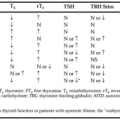DIFFERENTIAL DIAGNOSIS OF HYPOCALCEMIA
The history and physical examination are quite important in the evaluation of hypocalcemia. The goal of the bedside examination is to characterize the severity of symptoms and the duration of hypocalcemia, to detect underlying medical conditions, and to search for specific features of the various states of hypoparathyroidism and other disorders of mineral metabolism. Often, the clinical evaluation provides a tentative diagnosis that can be confirmed by appropriate laboratory tests.
An understanding of the causes of hypocalcemia (see Table 60-2) provides the basis for the clinical evaluation. If the patient is asymptomatic and the hypocalcemia has been detected by blood tests performed for other reasons, one should first estimate the likelihood of true ionized hypocalcemia by examining the concentrations of serum proteins. Occasionally, the measurement of ionized calcium by a reliable laboratory is helpful. Acute changes in the distribution of calcium between ionized and bound fractions may be indicated by a history of hyperventilation (respiratory alkalosis), recent massive blood transfusion (citrate), trauma with rhabdomyolysis, tumor lysis after chemotherapy, or phosphate administration by enema or intravenous infusion.
Transient hypoparathyroidism can often be anticipated (in neonates and in patients with parathyroid suppression after treatment of hypercalcemia); therefore, it is usually not a diagnostic problem. Reversible hypoparathyroidism associated with hypomagnesemia may be suggested by a history of alcoholism, gastrointestinal disease, or treatment with drugs that cause renal magnesium wasting. Chronic genetic or acquired hypoparathyroidism often is associated with characteristic features, such as family history, abnormal habitus, other endocrine disturbances, or a history of damage to the parathyroid glands. Steatorrhea, liver disease, or renal insufficiency may suggest a deficiency of vitamin D metabolites (see Chap. 63).
One occasionally may be confronted with a patient in tetany for whom no previous medical history is available. Even if urgent therapy is deemed necessary, a blood sample should be obtained quickly, before the administration of calcium, for the determination of levels of calcium, phosphorus, blood urea nitrogen or creatinine, albumin, electrolytes, and magnesium, and for PTH radioimmunoassay. The results of these determinations can direct the subsequent evaluation.
Stay updated, free articles. Join our Telegram channel

Full access? Get Clinical Tree





